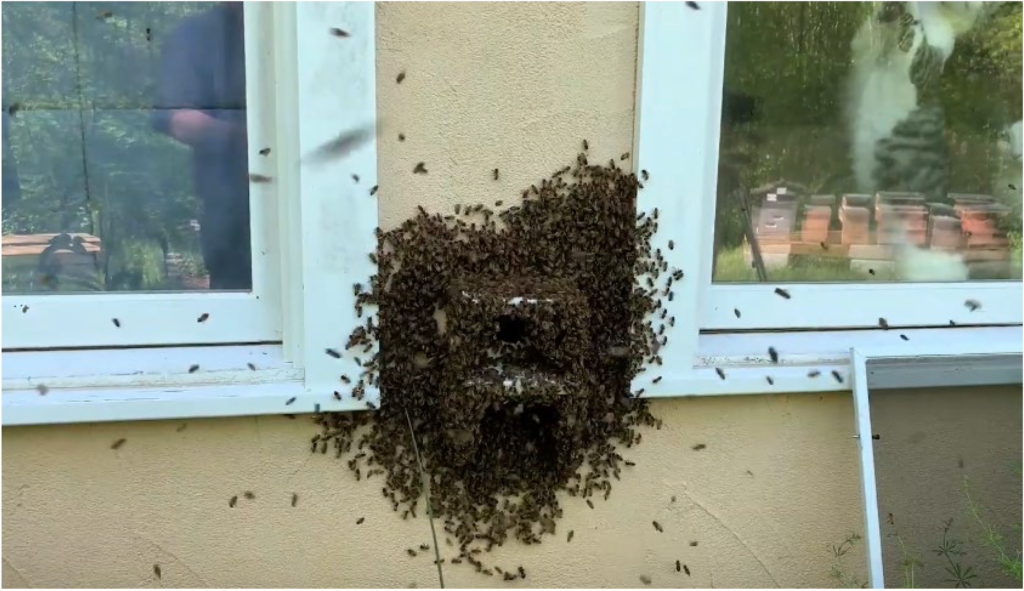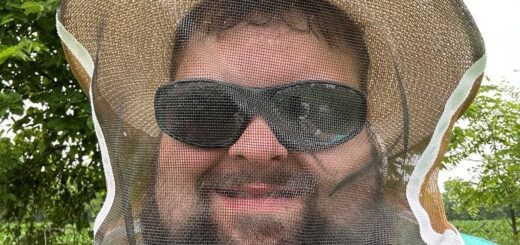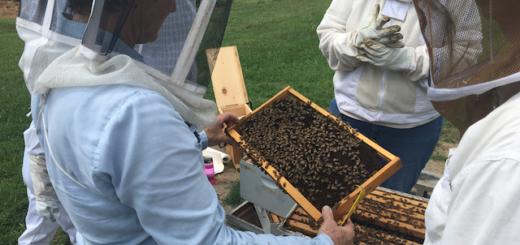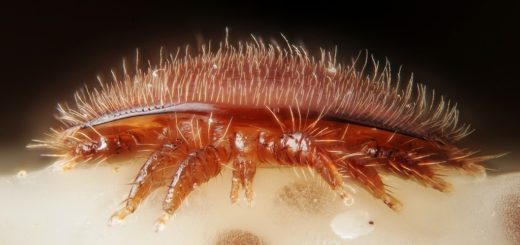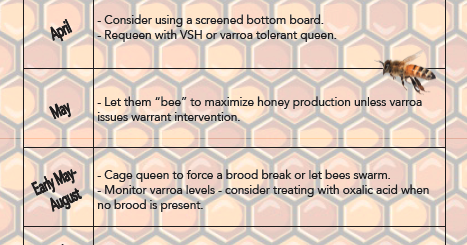In the Apiary: Daniel Harnden
April 3, 2021
DANIEL HARNDEN

How long have you been keeping bees?
It was 1983 when I purchased my first colony while living in Tampa, Florida.
Tell me about what drew you to the idea of beekeeping?
In 1970 when I was in 5th grade, our science teacher had a 3-frame observation hive with a clear plastic tube that led out the 3rd story window of our elementary school. At the time I thought I wanted an ant farm but when I saw the honeybees coming back with pollen and tending the queen, I knew it was going to be bees for me. My father had an early subscription to The Mother Earth News magazine and sometime around 1977 I remember reading an article on how to make your own bee equipment. I made all the parts for a 10-frame deep colony (except for the frames), but when I mentioned the new honeybees that we would soon be getting our next-door neighbor said that he was allergic to bees and asked us not to get bees. So, getting bees was postponed.
Describe the day you got your first package, nuc, or full hive.
I think I found an advertisement in the classified section of the newspaper offering a 10-frame colony of bees for $50. Besides the bees, it also included all the woodenware too. I drove to the trailer park where the beekeeper lived, and we stuffed the entrance with a window screen and loaded the colony onto the back of my pickup truck. I had built a hive stand ahead of time so when I got home, I set the colony up in the backyard and inspected it right away because I wanted to see the queen. She was beautiful!
Those bees and all the bees I kept in the 1980s always did very well. Beekeeping was different back then because it was pre-Acarine mites (Tracheal mites). All you really had to do was set up a hive in the spring and keep adding supers until the fall and then just collect the honey. There were not any bee schools, so I had never seen an open hive before my first one. Everything I knew or thought I knew came from reading the Hive and the Honeybee.
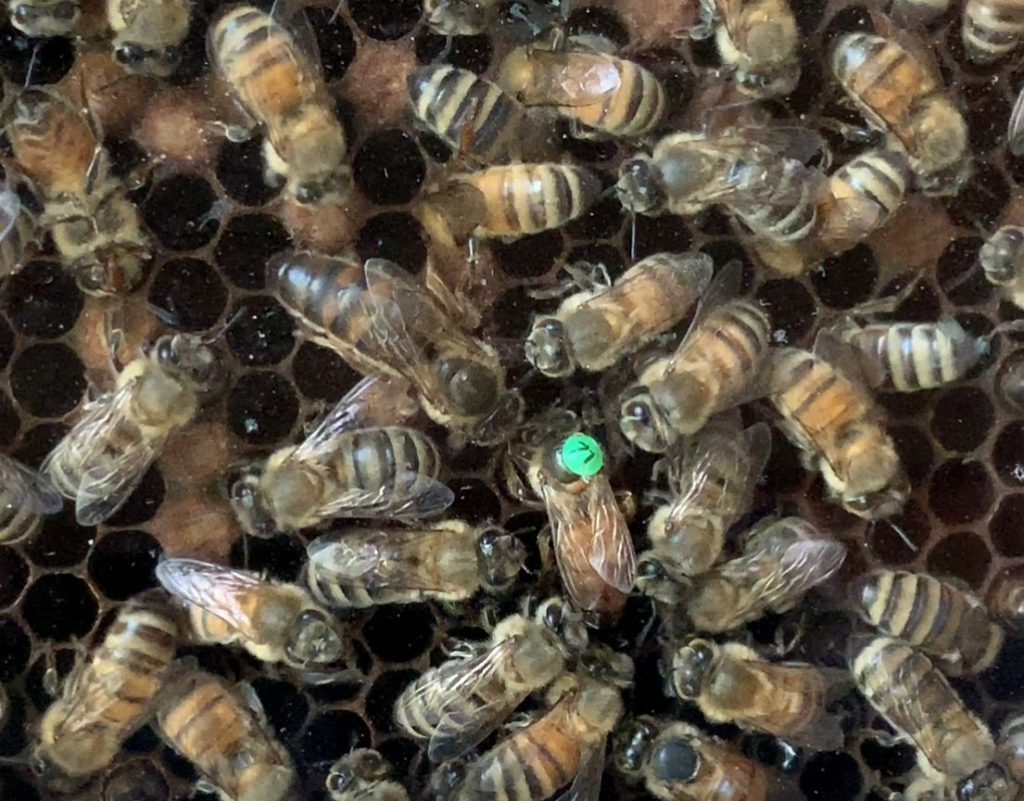
Do you name your queens and/or colonies? If so, share the names and how you came up with them.
Mostly not proper names, but there was the “the Wolf Spider” (as seen in Figure 1 above) from last year who was an awesome queen produced in our primary observation hive. After the observation hive swarmed with old queen, the new queen was despised by her daughters and sisters.
Before too long the workers started constructing supersedure cells and I decided to leave those cells un-molested to see what would happen. What happened a new virgin was produced and then successfully mated. This new daughter queen was much bigger and more productive than her mother. Both mother and daughter coexisted for months before mom disappeared sometime in late fall.
Tell me about your current hives, including hive style and apiary set-up.
We keep a mix of 4-frame, 5-frame, 8 -rame and 10-frames Langstroth style hives. Our main goal is to produce as many brood frames as possible. To do this we split a 10-frame box down the middle with a divider to create two four frame colonies. To help the bees and especially queens coming back from a mating flight we use colorful disk entrance reducers each with its own symbol/color combination. In the past, we used to thumbtack playing cards next to the entrances of our hives so that each hive entrance had a unique visual pattern near the entrance, but we have found the disk entrance reducers to be helpful in several ways.
- Easy to close off the hive when moving a hive
- Easy to reduce the entrance down to a minimum to discourage robbing
- Platform for colorful symbols to reduce drifting and ensure return from mating flights
- Good platform to attach marked magnetic disks that give us a visual indication of status, i.e., queen number or mating status
The hive below was recently given 3 frames of brood and nurse bees and 1 frame of pollen on each side. The red “QC” magnets in Figure 2 are reminders to not inspect these colonies to avoid disturbing the queen cells inside.
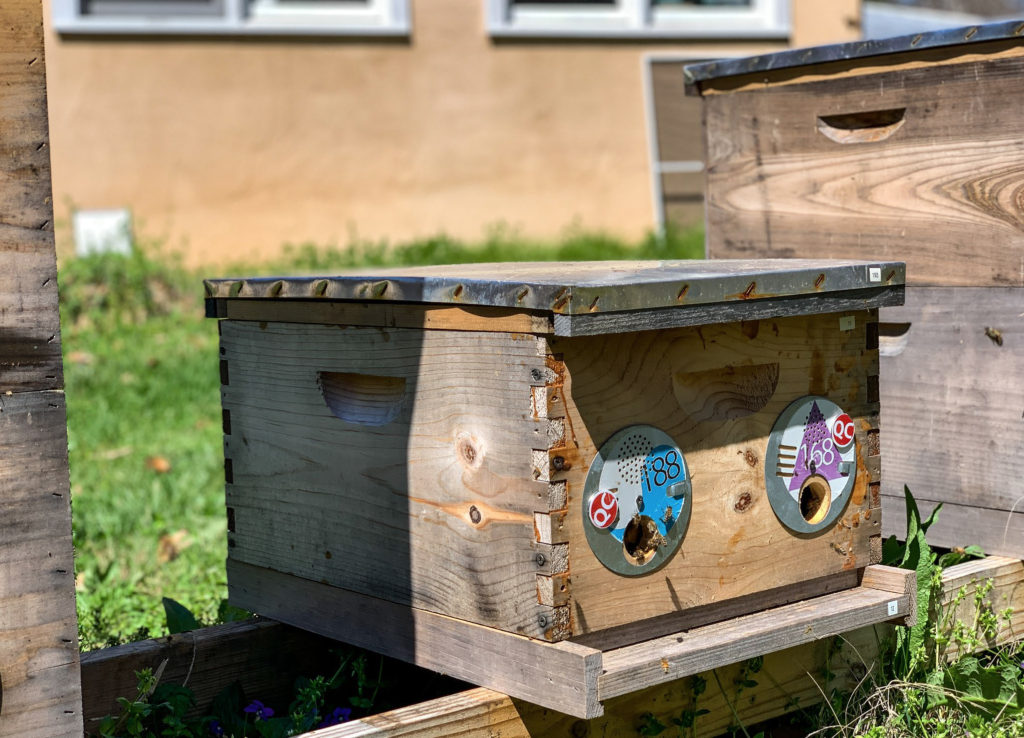
The 4 frame nucleus colonies are also used to support honey production by using the power of 2 queens working in the same hive. In the photo in Figure 3 you can see two 4-frame deep colonies sitting on a 10-frame bottom board side by side. Hive 56 (Yellow Hexagon) is facing South.
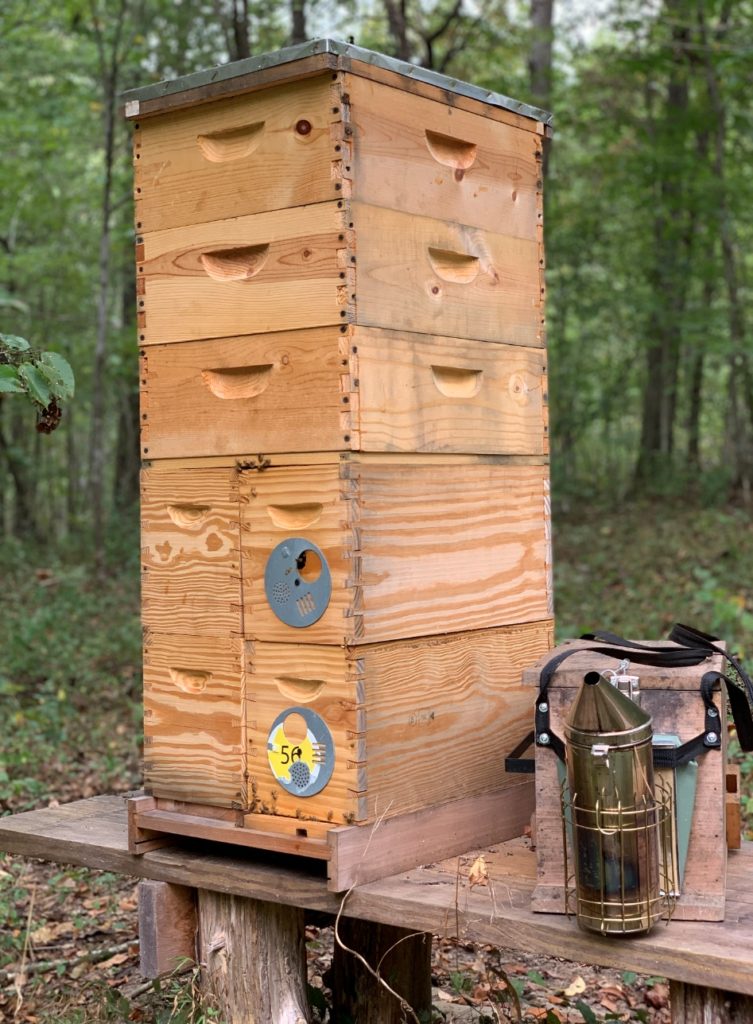

We keep track of the genealogy of each of the mothers of each of our queens by numbering all of the queens in our apiary. After a virgin queen is mated we evaluate her for several quality traits including brood pattern, temper, and productivity. Once she has been evaluated she is marked with a small plastic disk glued to her thorax, (Figure 5 below). By keeping track of individual queens, you see some interesting behavior like a swarm leaving one hive and taking over another hive. This is not something you would know for sure if your queens were not numbered.
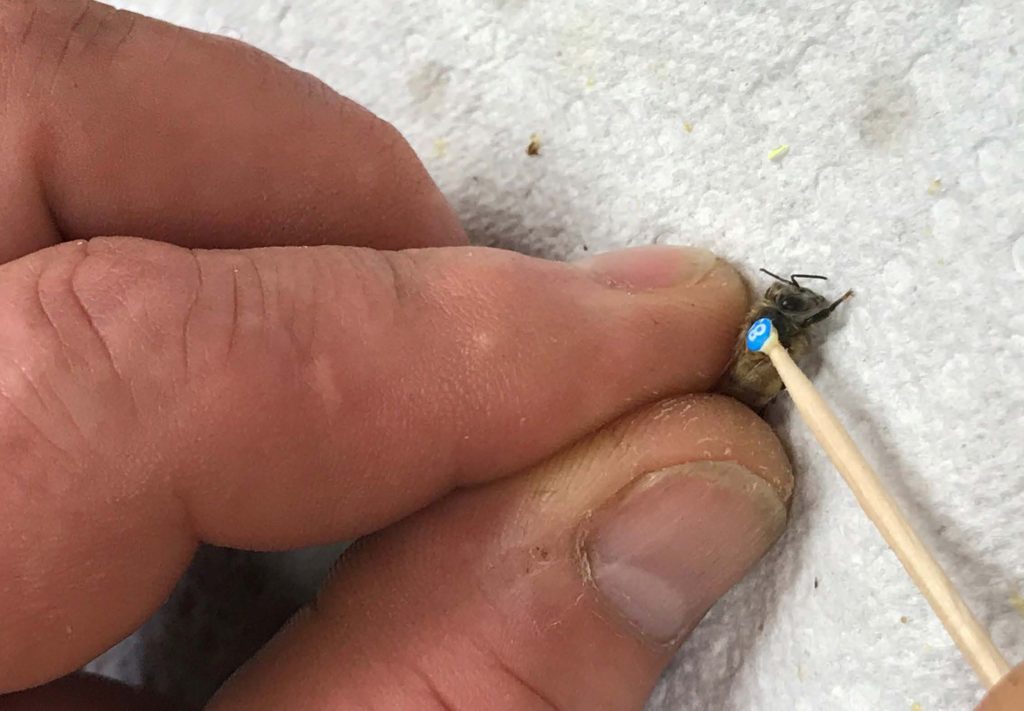
We have 3 apiaries, one in our back yard pictured in Figure 6, below, one about ¾ of mile from the house, and one about 15 miles away near Silk Hope. Figure 7, below, indicates hive and queen locations as well and the current number of brood frames in each colony.
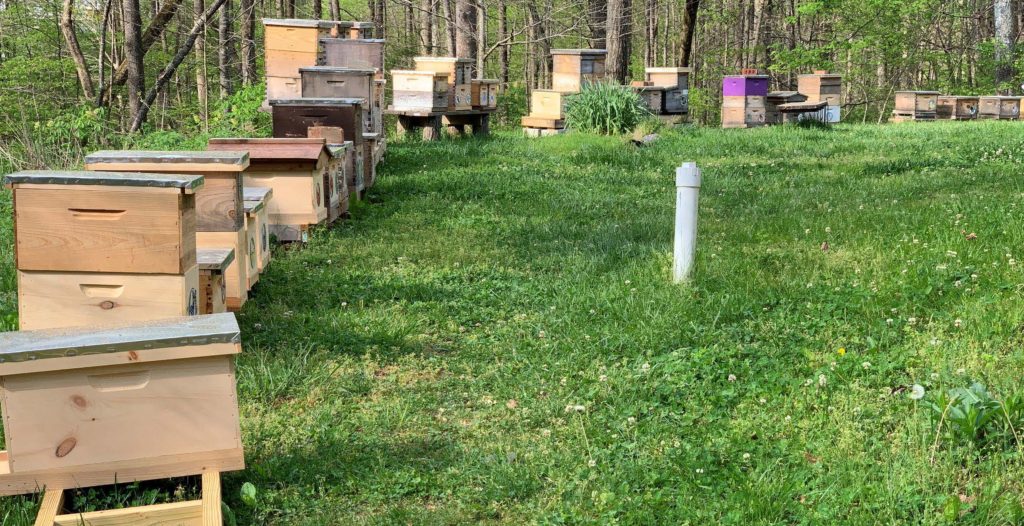
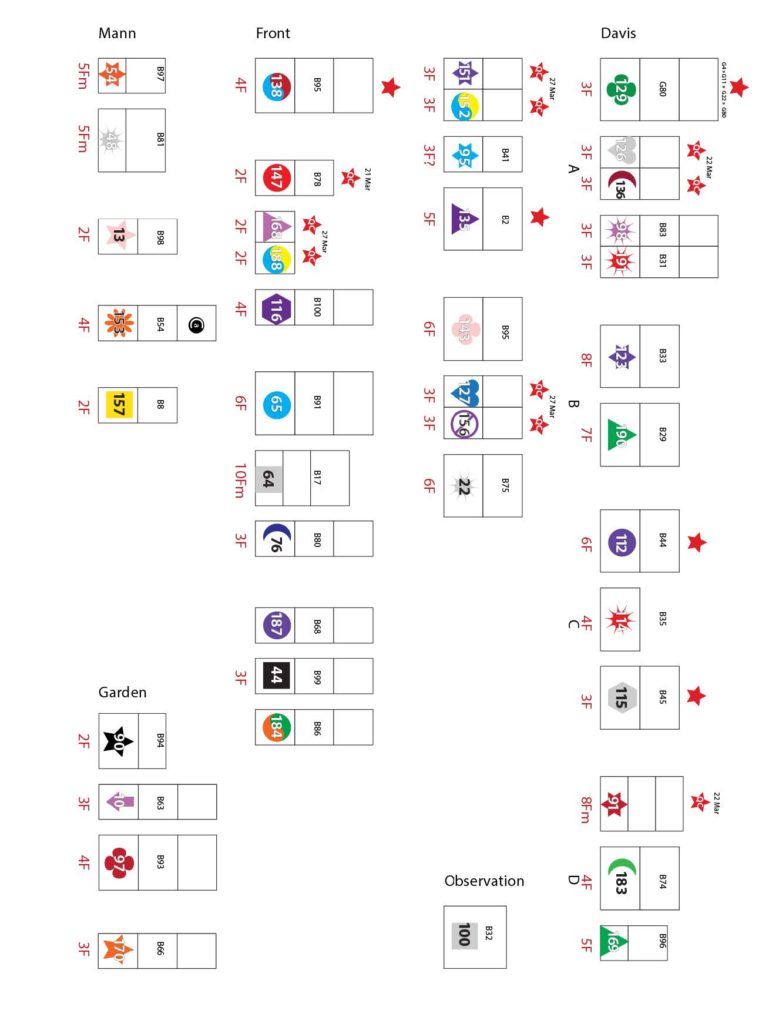
What is your favorite thing about keeping bees?
My favorite thing is that there is no end to learning about bee behavior and no end to learning about how they interact with their environment. If you like learning, then honeybees are the gift that keeps on giving. It is so hard to see the world from their point of view, living mostly in the dark, communicating with your sisters by sound and smell. And yet they can take appropriate coherent collective action in response to a mad rush of ever-changing signals from both from their own dark world and from the bright outside world.
How would you describe your beekeeping philosophy?
Help the honeybees do what want they to do. Help them succeed in their natural behavior. Meaning, make new queens and colonies during a honeyflow. Let them make drone comb because drones are a good thing. And don’t be afraid to feed them either pollen or nectar. Well-fed strong hives have the least problems.
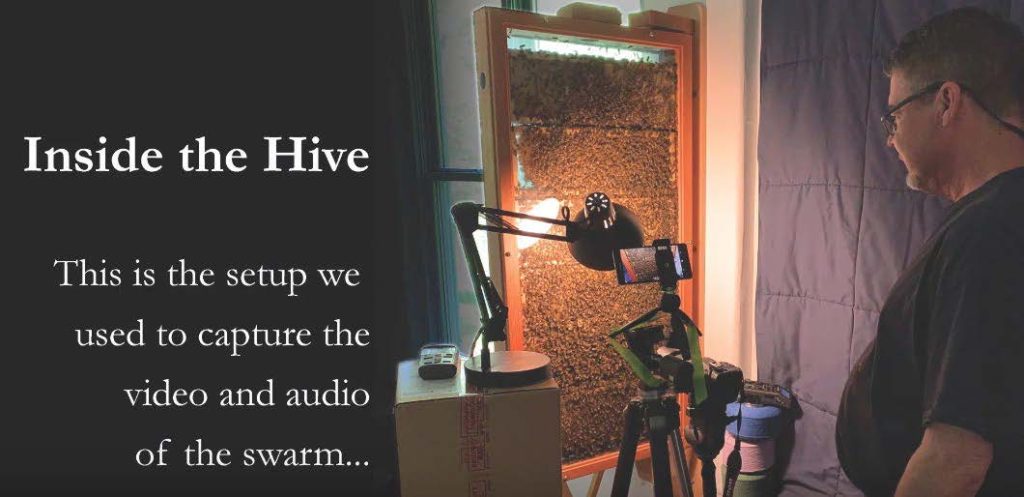
Tell me your favorite beekeeping story.
One of my favorite beekeeping stories involves trying capture on video the process of an observation hive swarming. I had been anxiously watching for signs of imminent swarming starting about a week after the initial swarm cells were capped. I set up cameras and microphones to record the event and even had a thermocouple inserted into hive to monitor pre-swarm temperatures. ( Figure 8, above)
I waited all day on Tuesday, and I waited all day on Wednesday until late afternoon. I took a 15-minute break to go out the garage to put together a beehive and when I came back almost all the bees were gone from the observation hive. They had swarmed! I could not believe that they took off in that short amount of time. I went outside and sure enough, they were 75 feet up in the top of a Tulip Poplar. I came back inside dejected and moped around for ½ an hour feeling sorry for myself. And then I heard a noise outside and when I went out, I saw all these bees flying around the entrance of the observation hive. Suddenly it became a thick cloud of bees and they were going back in the observation hive. The swarm was coming back! I was speechless. (Figure 9, below)
It was ones of those times in life when I was given a second chance and I am so grateful for that.
The next day in the late afternoon the temperature in the observation hive suddenly began to rise. The workers were relentlessly harrowing and biting and tugging at the multiple queens that were now running about the hive. The hive sounded as if a tornado was approaching. In just moments it was if the whole hive turned to a brown viscous liquid and insanity ruled. It took less than 5 minutes for most of the bees in the hive to rush out outside and form a big cloud right at the entrance.
I could see one of the queens repeatedly trying to re-enter the hive. She was smart and knew she didn’t want to leave her nice safe warm home.
Luckily, I was able to capture video of the queen leaving with the swarm (and actually trying to get back into the observation hive) (Figure 10 below).
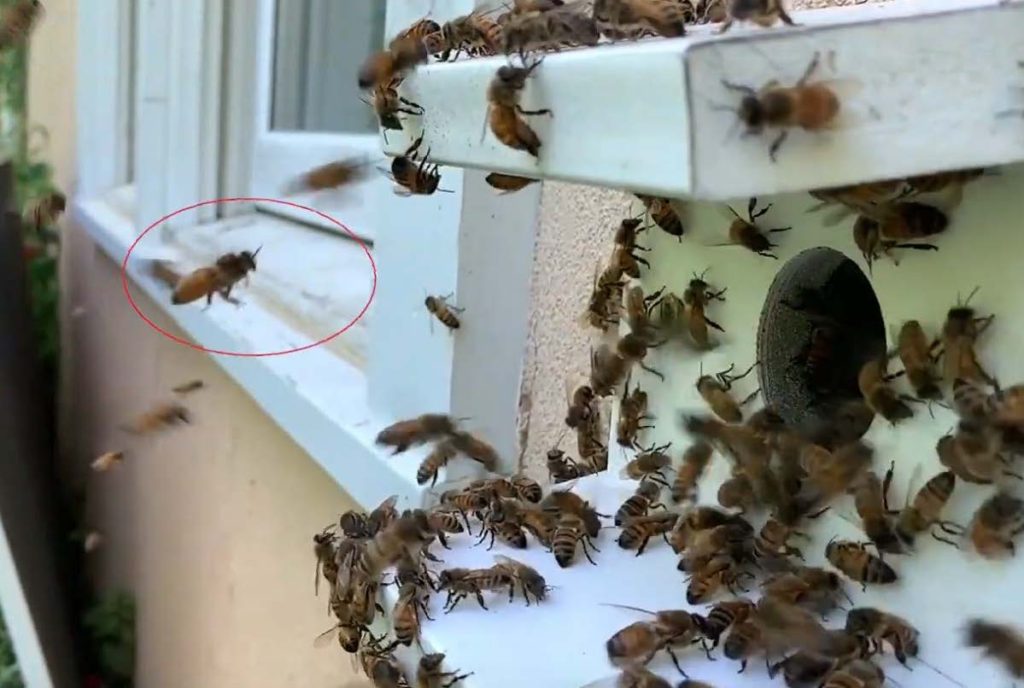
What was your experience with bees as a child? Any memories that come to you as you think about it?
My first memory of honeybees was when I was about 4 years old at my grandmother’s house. My cousin Robert and I would run around barefooted in the grass and the clover and when I would step on a honeybee, I would occasionally get stung. But seeing how a colony really operated in my elementary school’s observation hive when I was 10 opened my eyes as to what a fascinating little society a honeybee colony is.
Is there a beekeeper or mentor who has inspired you on your beekeeping journey? Feel free to share anecdotes and/or appreciation.
Dr. David Tarpy at NC State University – who taught me how to put number tags on bees and taught me the importance of having diversely mated large strong queens.
Any advice for a brand new beekeeper?
Keep your colonies strong. Feed your bees when needed. Attend the Club Apiary Day every chance you get. Chatham County Beekeepers Association is blessed to have so many experienced beekeepers who donate their time. That hands-on experience really is the best way to learn.
Add anything you wish I’d asked but didn’t!
What is your favorite race of honeybees?
Caucasians – I always wanted to keep Caucasian honeybees ever since first reading about them in the Hive and the Honeybee. Black, gentle, winter hardy and excellent propolis producers, but because the 1922 ban on the importation of honeybees into the United States not available.
But now, finally, pure Caucasians have become available thanks to work of Dr. Steve Sheppard and his team at Washington State University and their trips to the Caucuses to collect and return with Caucasian honeybee semen. Because Caucasian honeybees are from such a remote location (Republic of Georgia) the genes from these bees have an opportunity to make a significant contribution to the genetic diversity of our local stock. It is my main breeding goal for this year.

